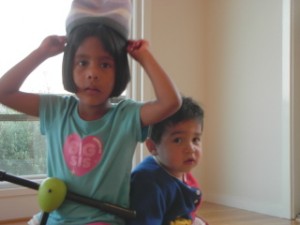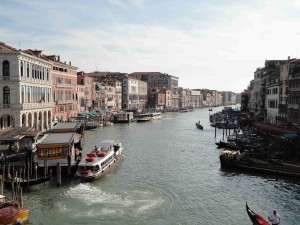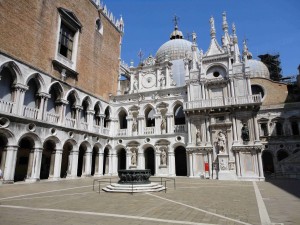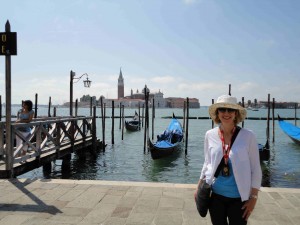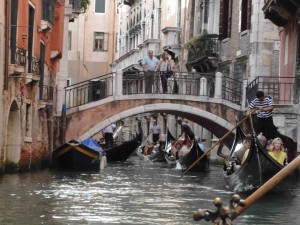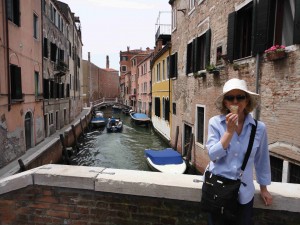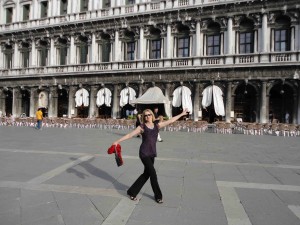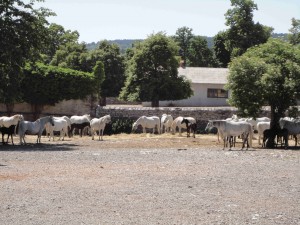Heritage Camp ended with a closing ceremony in which a dozen or so campers talked about the positive impact camp has made on their lives, in addition to being so much fun. One of my favorite observations came from an adoptive father who read a poem he’d written. I don’t have his words in front of me, but the gist of it was how Heritage Camp is about each child finding his or her own voice, and feeling confident enough to use it. Exactly. (more…)
Archive for June, 2010
Heritage Camp
Saturday, June 26th, 2010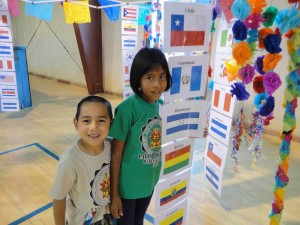 This is the third year I’ve been at the Opening Ceremony at Latin American Heritage Camp and I still cried. The children parade into the auditorium grouped according to their country of birth, carrying their country flag. The largest number of children were born in Guatemala—around 90—so they walked in first. Olivia and Mateo came in holding hands. Some other countries represented are Mexico, Belize, Honduras, El Salvador, Nicaragua, and Paraguay. Including presenters, about 450 people are attending.
This is the third year I’ve been at the Opening Ceremony at Latin American Heritage Camp and I still cried. The children parade into the auditorium grouped according to their country of birth, carrying their country flag. The largest number of children were born in Guatemala—around 90—so they walked in first. Olivia and Mateo came in holding hands. Some other countries represented are Mexico, Belize, Honduras, El Salvador, Nicaragua, and Paraguay. Including presenters, about 450 people are attending.
Being in a place where every family is a transracial adoptive family is extremely powerful. Olivia and Mateo feel this, too. Both of them are old enough to be aware that in their class at school, on sports teams, and in church, they are “the adopted brown kid with white parents.” At Heritage Camp, every child is adopted. I try to imagine a similar parallel in my life, and I can’t. Adoption is a defining experience like no other. Because I’m not adopted, I can never truly understand what that experience feels like. Being at Heritage Camp raises my awareness and sensitivity to how profound the experience is. (more…)
Continental Divide
Thursday, June 24th, 2010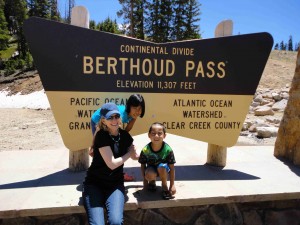 Tim, Olivia, Mateo, and I landed in Denver airport yesterday afternoon, en route to Latin American Heritage Camp. As I mentioned in a previous blog post, Latin American Heritage Camp is designed for children born in Central and South America and their adoptive families. Heritage camps exist for children adopted from most places around the world. Attending is one of our favorite traditions. This is our third year. (more…)
Tim, Olivia, Mateo, and I landed in Denver airport yesterday afternoon, en route to Latin American Heritage Camp. As I mentioned in a previous blog post, Latin American Heritage Camp is designed for children born in Central and South America and their adoptive families. Heritage camps exist for children adopted from most places around the world. Attending is one of our favorite traditions. This is our third year. (more…)
Who am I?
Tuesday, June 22nd, 2010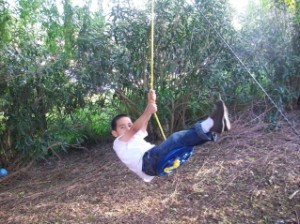 This morning, for the second time this week, Mateo asked me “Are you my real mom?” Despite how attached I know my son is to me, he continues to wonder about this key issue. As an adoptive mother—or at least as the adoptive mother to my two particular children—I’m used to this and other family-related questions. (more…)
This morning, for the second time this week, Mateo asked me “Are you my real mom?” Despite how attached I know my son is to me, he continues to wonder about this key issue. As an adoptive mother—or at least as the adoptive mother to my two particular children—I’m used to this and other family-related questions. (more…)
Adoption in Real Life
Sunday, June 20th, 2010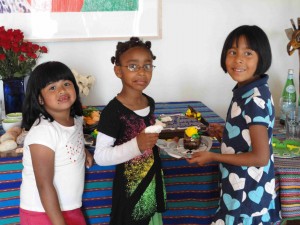 A friend sent me a link to an episode on The View that ran on Friday, June 16. The subject was international adoption, as it was experienced by adoptive parents who are not celebrities. Guests included blogger Kristen Howerton, mother to four children—two biological and two adopted (one from the U.S. and one from Haiti). Other guests were Adam Pertman, Executive Director of the Evan B. Donaldson Adoption Institute; a single mother; and a gay couple. (more…)
A friend sent me a link to an episode on The View that ran on Friday, June 16. The subject was international adoption, as it was experienced by adoptive parents who are not celebrities. Guests included blogger Kristen Howerton, mother to four children—two biological and two adopted (one from the U.S. and one from Haiti). Other guests were Adam Pertman, Executive Director of the Evan B. Donaldson Adoption Institute; a single mother; and a gay couple. (more…)
The Recital
Wednesday, June 16th, 2010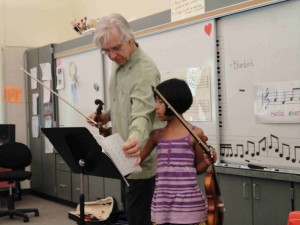 The previous year of anguish around Olivia’s practicing violin was a distant memory when she performed with seven other students in a small recital on Tuesday afternoon. Forgotten were the threats, the tears, the stomping down the hallway with screams of “I hate violin!” Instead, she and I savored the performances of the other students, and basked in a feeling of tremendous accomplishment when she completed her songs, “Fire in the Mountain” and “The Partridge.”
The previous year of anguish around Olivia’s practicing violin was a distant memory when she performed with seven other students in a small recital on Tuesday afternoon. Forgotten were the threats, the tears, the stomping down the hallway with screams of “I hate violin!” Instead, she and I savored the performances of the other students, and basked in a feeling of tremendous accomplishment when she completed her songs, “Fire in the Mountain” and “The Partridge.”
This being California, the performers dressed casually. Olivia paired her favorite multi-colored skirt made in Guatemala with neon green Converse; other students chose Vans sneakers, leggings, and board shorts. Of the eight students, five were boys. If I had to guess, I would say that most of them, in their spare time, skateboard or surf. The girls, I know, play soccer.
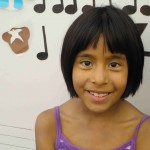
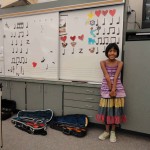
Chills ran down my spine when I saw how music animated each one of them, slumped in a metal folding chair only minutes before. The older, more advanced students, especially, came alive. Such intensity in their eyes, the way they handled the bow, their fingers. But even beginners like Olivia were transformed. The music teacher, Mr. Kit Eakle, must have been extremely proud of his small but dedicated cadre. This year, Mr. E will retire from the public schools, where he has had a long career teaching music in addition to his own performing and composing. At the end of the concert, he gave each student a CD featuring outstanding performances on the violin. He will continue to teach privately.
On the Monday afternoon before the recital, Olivia and I had agreed, “No more violin.” Now, we’re not so sure.
Violin
Monday, June 14th, 2010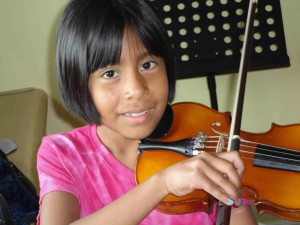 Learning to play violin was Olivia’s idea. Neither Tim nor I is musical. We can’t even read music. But whenever we drive, we tune the radio to classical. It soothes the tensions that seem to arise as soon as the kids are buckled into their car seats.
Learning to play violin was Olivia’s idea. Neither Tim nor I is musical. We can’t even read music. But whenever we drive, we tune the radio to classical. It soothes the tensions that seem to arise as soon as the kids are buckled into their car seats.
Almost from her first hearing of a symphony, Olivia picked out the violin and began asking for lessons to play it. I was thrilled that she liked the instrument so much, but didn’t want to push her into something she wouldn’t continue. I relented after she asked for a year; only then did I believe she was serious. We made a pilgrimage to Ifshin’s, a music store in Oakland that specializes in strings, and rented a quarter-size violin. I enrolled her in an after-school program, one half-hour lesson per week. (more…)
Last stop, Venice
Thursday, June 10th, 2010If it’s Tuesday, this must be Slovenia
Tuesday, June 8th, 2010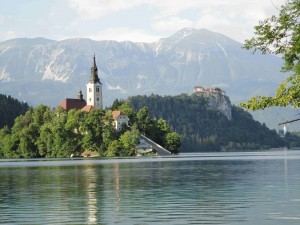 Slovenia. Who knew? Maybe everyone else is aware of this tiny country, half the size of Switzerland and squeezed in between Austria, Hungary, Croatia, Bosnia, and Italy, but I wasn’t. Prosperous and energetic, Slovenia is a member of the EU. It’s a paradise for anyone who loves adventure sports, with hiking, mountain biking, and rowing, and also a great place for children. Everywhere we went, we said “Olivia and Mateo would love this.” Tim insisted that someday Slovenia will be the first European country our children will visit.
Slovenia. Who knew? Maybe everyone else is aware of this tiny country, half the size of Switzerland and squeezed in between Austria, Hungary, Croatia, Bosnia, and Italy, but I wasn’t. Prosperous and energetic, Slovenia is a member of the EU. It’s a paradise for anyone who loves adventure sports, with hiking, mountain biking, and rowing, and also a great place for children. Everywhere we went, we said “Olivia and Mateo would love this.” Tim insisted that someday Slovenia will be the first European country our children will visit.
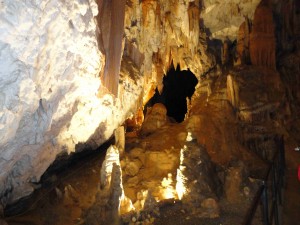
One of our favorite places for kids was the Postojnska Jama (Postojnska Caves), said to the second largest cave system in the world, after Mammoth Caves in Kentucky. I’ve never been to Mammoth, but can’t imagine anything more spectacular than the Postojnska Jama. You ride a small train through narrow tunnels that twist and turn like a ride at Disneyland, passing stalactites and stalagmites that look like otherworldly figures, organ pipes, or spaghetti, then get out and walk for an hour through open chambers and over gorges. The other place our children would love is the town of Lipica, home of the stud farm where the white Lipizzaner horses were first bred. The mother horses had just foaled, so lots of little colts were prancing around. We walked through the stables, and I managed to eat an ice cream, too. Definitely a child-friendly place.
We drove through the Soca Valley, where Ernest Hemingway set part of his novel, A Farewell to Arms. As soon as we return home, I plan to reread the book. The valley is a haven for kayakers, rafters, rock-climbers, and mountaineers. The color of the water in the Soca River is a green blue I’ve never seen before. Gorgeous.
The best place of all was Lake Bled. For centuries, this spa town at the foot of the Julian Alps has been a destination for Europeans seeking the cure in its thermal waters. The late Yugoslav president Tito had a summer home on the lake, so you know it’s picturesque. A footpath surrounding it is used by walkers, bikers, and mothers pushing jogging strollers. The lake is also the site of international rowing activity. Several teams of rowers from Bled have medaled in the Olympics, including a gold in 2000. With a circumference of five miles, Lake Bled is one-tenth the size of Lake Tahoe. It’s charming, manageable, and perfect.
Slovenia. Check it out.
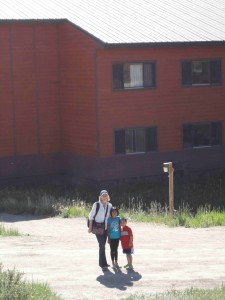



 ShareThis
ShareThis